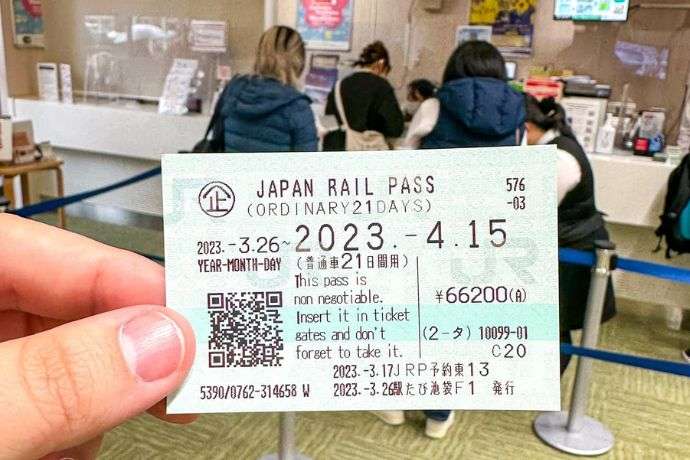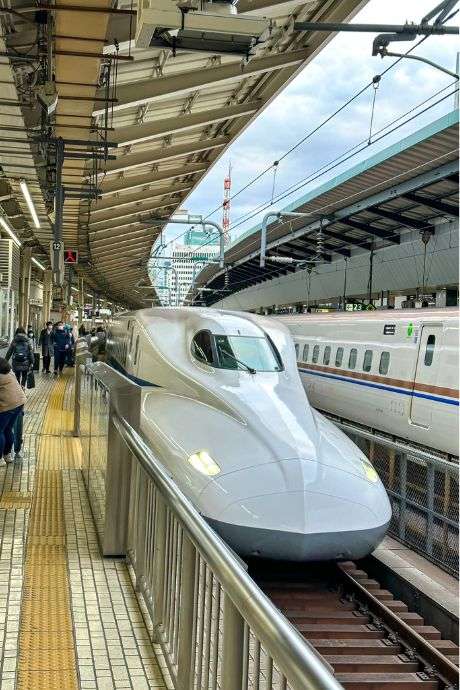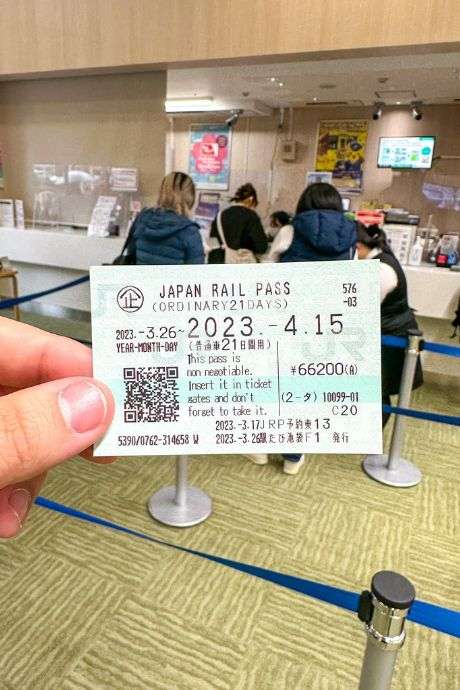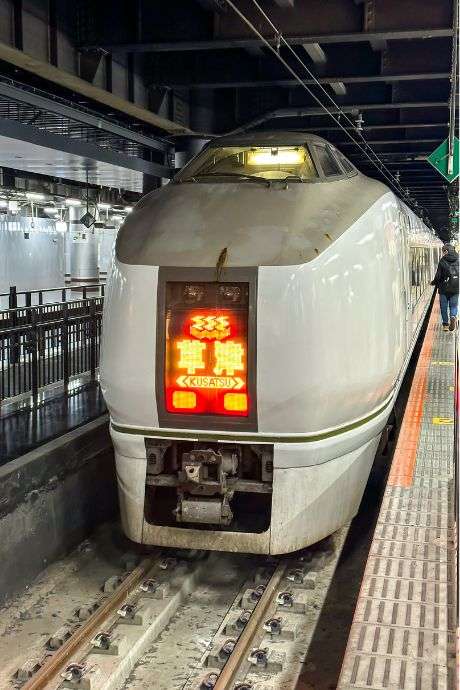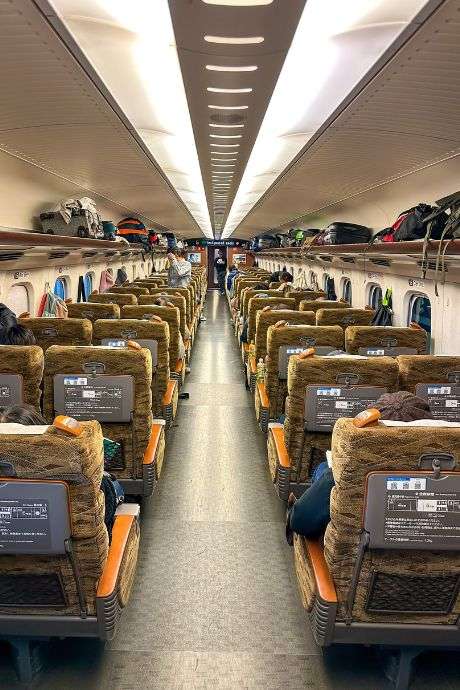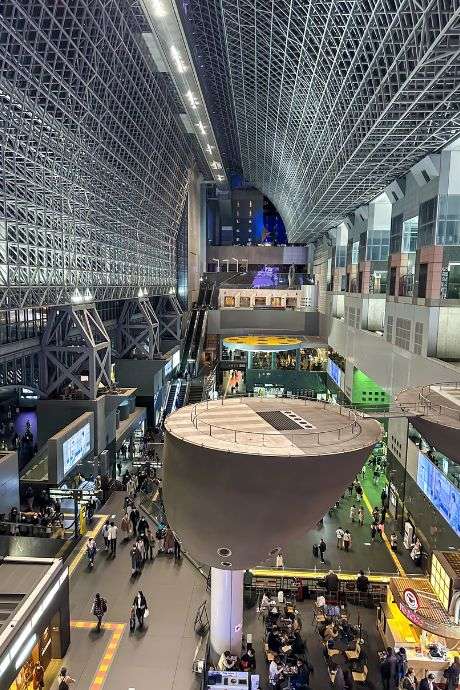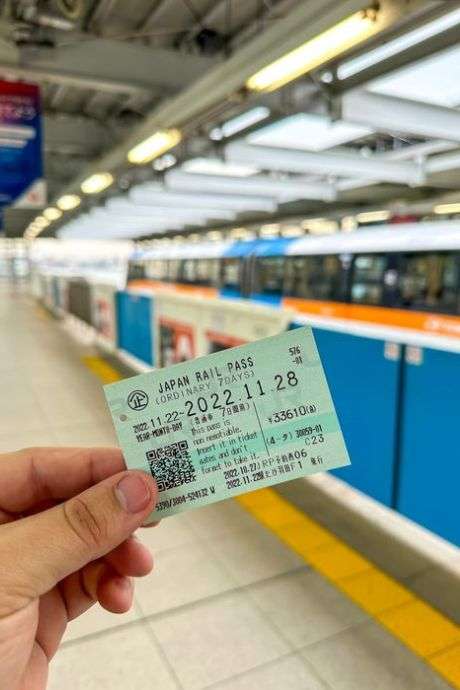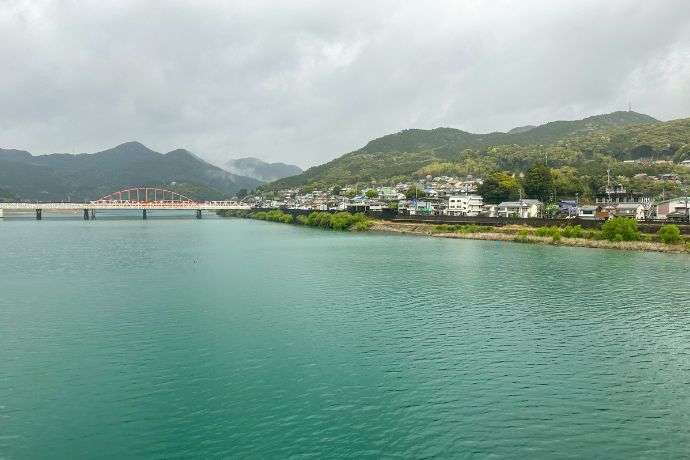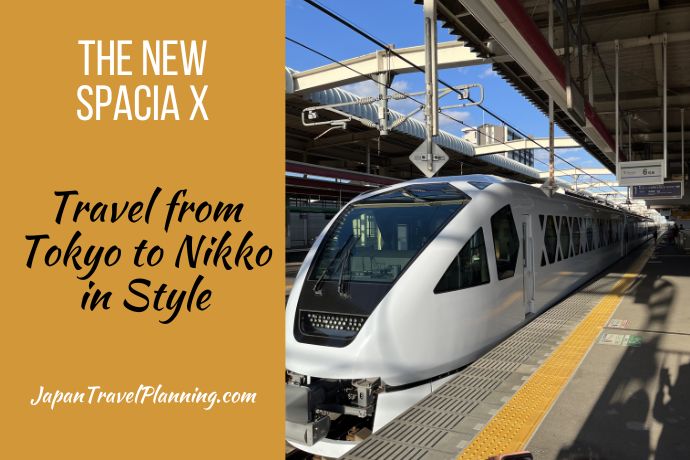Japan has a highly efficient and comprehensive rail network that allows convenient travel to almost any destination. You can plan an entire Japan trip using only trains! Even better, the JR Group offers unique passes for foreign visitors for unlimited train travel on their train lines. However, they are not cheap and are about to get more expensive. This means almost everyone planning a trip to Japan asks the same question – Is the Japan Rail Pass worth it?
When only visiting one metro area in Japan, there are many options for transport and so a Rail Pass won’t make sense. But for any itineraries to Japan that include travel between cities, the value of the JR Pass can quickly add up and make the expenditure worth it.
- Free Global Shipping through Klook.
- Easy to make and adjust travel plans on the go in Japan
- 7, 14 or 21 consecutive days, with free seat reservations
- Covers most Japan Rail trains, buses and ferries in Japan
Is the Japan Rail Pass Worth It?
Ever had a question like one of the following? Should I get a JR Pass? How do I make the most of a JR Rail Pass? This guide covers everything from securing and activating your pass to evaluating its worth. As a seasoned user of the JR Pass, I’ve provided practical insights based on my personal experience, including detailed case studies of 7-day and 21-day JR Pass usage.
In this article, I will be covering the following topics to help you decide if a Japan Rail Pass is worth it and to also help you master the art of getting the most out of a JR Pass:
- 2023’s JR Pass Price Hike: What’s Changing?
- Comparing the Current and Upcoming JR Pass Prices
- Inside Your JR Pass: What’s Included
- New Additions Coming with the 2023 Price Hike
- Beyond the Money: Additional Benefits of a JR Pass
- Securing Your JR Pass: A Simple Purchasing and Activation Guide
- To Use or Not to Use: Making the Most of a 7-Day Pass
- Maximizing Savings: A 21-Day JR Pass Cost-Benefit Analysis
- Reevaluating Itineraries: Are the 7-day and 21-day Passes Worth it After the Price Hike?
- Answers to Frequently Asked Questions
Why is the price increasing in 2023?
Adding to the debate about is a Japan Rail Pass worth it, Japan Railways has announced that from 1 October 2023, the cost of the Rail Pass will be increasing.
Why now? As with everything else in the world currently, inflation is real, and prices are increasing for everything. The JR Pass has not increased in price for a long time, so JR is now catching up. Also, remember the exchange rate, which is much better for visitors to Japan now than it has been in a very long time.
At the current prices, JR Passes are a steal – one of the best deals in travel. With the price increases coming, the cost of a JR Pass is normalised and still reasonably priced for an itinerary that uses it to its maximum potential.
Also, base tickets will be rising as well, so the value of the pass will still be relative to the cost of all tickets you would need to cover the same ground.
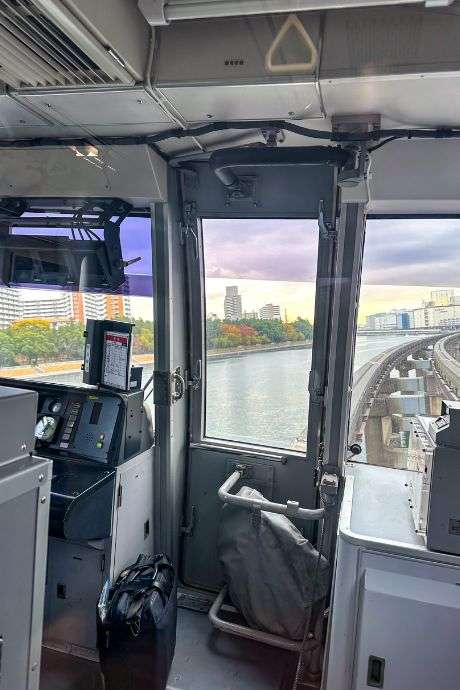
JR Pass Price Comparison
While there are still exact details to come from JR, such as timing and what will be included, they did share what the price changes will be for the JR Pass. Below is the current Japan Rail Pass price and what they will increase to from 1 October 2023 for an adult ticket.
The difference between an ordinary pass and a green car pass is in the seat types on long-distance trains, such as the Shinkansen (bullet train) and limited express trains.
There are no green cars on most local trains. Green cars will be a little more spacious and quiet than an ordinary car, if that is important for you while travelling. But even the ordinary car offers plenty of legroom and is sufficient for most travellers.
| Pass Type | Current Price | New Price | Price Increase |
| Ordinary 7-Day | 29,650 yen ($206) | 50,000 yen ($348) | 67% |
| Ordinary 14-Day | 47,250 yen ($329) | 80,000 yen ($557) | 69% |
| Ordinary 21-Day | 60,450 yen ($421) | 100,000 yen ($696) | 65% |
| Green Car 7-Day | 39,600 yen ($276) | 70,000 yen ($487) | 77% |
| Green Car 14-Day | 64,120 yen ($446) | 110,00 yen ($766) | 72% |
| Green Car 21-Day | 83,390 yen ($580) | 140,00 yen ($974) | 68% |
JR Pass Increases in yen and USD, based on June 2023 exchange rates
These price increases are pretty steep, with the price of a green car pass increasing slightly more than that of an ordinary pass.
As before, the price of an ordinary 21-day pass is still less expensive than a 14-day green car pass, gaining an extra week of travel in exchange for a little bit of space. With these new price changes, evaluating if the pass is worth it will be even more critical.
What does the JR Pass Include?
The core product of the JR Pass is unlimited travel on all JR Train lines, with some exceptions. It includes local JR Lines (such as the Yamanote Line in Tokyo), most limited express or inter-city trains (such as the Kusatsu Express from Tokyo to the famous onsen town), and long-distance trains, including the Shinkansen (bullet trains).
Platforms for JR trains are clearly marked with signage for “JR Lines” or “Shinkansen”, and the ticket turnstiles will accept your JR Pass.
Note: Two types of Shinkansen are not currently included in the JR Pass – the “Nozomi” and the “Mizuho” .
Airport Transfers
However, there are still some other uses for the JR pass that can come in really handy. If you time up the usage period of the pass with your arrival or departure from Tokyo Narita or Haneda, the pass covers the Narita Express or Tokyo Monorail respectively.
Buses and Ferries
JR also operates buses in some cities, such as Kyoto and Kanazawa that run to popular tourist attractions. Not all buses are covered by the JR pass in these locations. The pass only works for JR buses.
Additionally, JR operates a ferry to the extremely popular island of Miyajima, close to Hiroshima.
While the cost of these types of buses and ferries is generally low, the convenience of the JR pass makes them a nice plus and still contributes to the monetary value.
What new things will be included after the 2023 price increases?
The price going up is not all bad news, as JR has teased some new perks will be coming with the new rail pass. One right off the bat is consistent pricing across all platforms – the current pass can be more expensive depending on where or how you purchase it.
Secondly, there will be an option to upgrade to Nozomi or Mizuho trains, with a small surcharge payable. While we don’t know what this upcharge will be yet, there is potential to save a lot of time or have more convenient schedules when travelling on the corridor between Tokyo, Kyoto, Hiroshima, etc.
Lastly, JR has shared plans to expand significantly the discounts one can receive at various attractions and locations of their partners, potentially helping to cover some of that extra cost of the pass.
The Convenience and Flexibility of a JR Pass
If you’ve been wondering, “Should I buy a JR Pass?” there are other factors beyond the cost to think about. Using a JR pass is not only beneficial for saving money. It adds a level of convenience to your trip that you can’t put a price on. For example, you can book and reserve seats on trains with reserved seats an unlimited amount of times before travel (assuming times don’t overlap).
It’s also super easy to stop by a green ticket machine and make reservations or pick up reservations if you purchased your pass online. It’s all self-serve, and you don’t even have to talk to a human unless in extraordinary circumstances.
These seat reservations are included with the pass and will help you avoid missing a busy train without worry. But if your plans change, you can cancel your reservation and book another train with no problem. It truly is the ultimate form of flexibility.
If you decide to go somewhere else or add a new destination while on your trip, you can do so without an extra cost. If you want to ride the bullet train for fun instead of a local subway, you can do it without spending all that extra yen. With a JR pass, you just get up and go on any train included in the JR pass whenever you want.
Having a pass also means you don’t have to fumble around with cash. Before you even leave for your trip, you know your transportation budget, and you don’t have to stop and buy tickets each time you want to ride a train. You insert your ticket and go! No coins are piling up in your pocket or figuring out how much the fare is.
Note: Do not print seat reservations until you need them; once you print them, you can’t cancel them or change them. This is the one time you may need to stop by a human at the ticket window.
How to purchase and activate a JR Pass
There are three main ways to purchase a rail pass:
- Buy a voucher from a travel agency such as Klook – they will ship the pass voucher to your location of choice, and you will exchange it for a pass when you arrive in Japan. This was traditionally the main way to get a pass at the best price, as these agencies may be able to discount them.
- Buy the pass when you get to Japan. It sounds simple, but it may take longer once you arrive, and you will pay full price.
- Buy the pass from the official Japan Rail Pass Reservation website. You still have to pick it up when you arrive in Japan. The benefit is you can reserve trains online, including before you even get to Japan, but this site currently has a higher price to purchase than the published price. This is believed to change once the price increases go into effect.
You can still reserve seats on trains with options 1 and 2 once you get to Japan and pick up the pass using the JR station’s green ticket reservation machines.
The JR Pass can only be picked up (exchanged) at certain stations in Japan at the dedicated travel centre, including both Tokyo Haneda and Narita, Kansai Airport, Tokyo Station, Ueno Station, and Shinagawa Station, amongst others.
You will need your passport and either the voucher or order number. This is the full list of exchange locations.
There are a few other things to be aware of when purchasing a JR Pass:
- A pass must be exchanged within 90 days of purchase. Only purchase a pass if you will be arriving in Japan within 90 days.
- Once you exchange a pass in Japan, you can choose a start date within 30 days. Most travellers start the pass pretty close to the date they pick it up, depending on their travel plans.
The reported date to purchase a pass at the current rates is on or before 30 September 2023. So that means anyone travelling to Japan before 28 December 2023 can purchase a pass at the current rates. For travel in 2024 and beyond, you will have to wait for the new JR passes to be available from 1 October 2023.
Using a JR Pass for a 7-day Itinerary
Most visitors to Japan want to see the major sights in Tokyo, Kyoto, Osaka, and potentially other nearby spots like Hiroshima, Nara, etc.
If you only travel in one direction (such as Osaka to Tokyo) or stay in one city the whole time, a 7-day rail pass will likely not be worth it. But once you take a round-trip bullet train from Tokyo to Osaka or Kyoto, the pass price can quickly become worth it and nearly covers the cost. Once you add in local trains or day trips, you can get a lot of value for your money.
Here is an example of a basic 7-day itinerary from Tokyo that includes two days in Osaka, a day trip to Hiroshima and Miyajima, two days in Kyoto, and two days in Tokyo (with a trip to Mt. Fuji) that maximises the value of the pass.
Only buy the JR pass for the days you are moving between cities. Days in Tokyo can be added to either end of this trip, but you wouldn’t use the JR Pass for this. Instead, you could buy a Suica and use local subways that aren’t included in the JR pass.
| Day | Route | Ticket Price (in yen) |
| 1 | Tokyo – Osaka one way (Shinkansen) | 14,720 |
| 2 | Osaka local subways | n/a |
| 3 | Osaka – Hiroshima round trip (Shinkansen) | 21,900 |
| 3 | Hiroshima – Miyajimaguchi round trip (Train) | 840 |
| 3 | Miyajima Ferry round trip | 360 |
| 4 | Osaka to Kyoto one way (Shinkansen) | 3,080 |
| 5 | Kyoto local subways/buses | n/a |
| 6 | Kyoto – Tokyo one way (Shinkansen) | 14,170 |
| 7 | Shinjuku-Otsuki round trip (Fuji Express Train) | 4,720 |
The total cost of tickets for this travel is 59,790 yen or US$ 416.
Compare this to the current 7-day pass at $206 there is considerable savings! Even at the new price of US$ 348, there are some nice savings. And you may take some other local JR trains or buses around Tokyo, Osaka, Kyoto etc., which will further add to the value of the pass.
With a less intense itinerary, however, the 7-day pass may not be worth it. For example, if you do a one-way trip from Osaka to Tokyo (dropping the Tokyo – Osaka leg) the value of the tickets is now 45,070 yen or US$ 313 which is less than the new US$ 348 price. However, you could argue adding some other tickets (such as an airport train) or the convenience would still make the pass worth it.
If you start and end in Tokyo and only do a round trip to Kyoto, that will cost you 28,340 yen or US$ 197, so that alone wouldn’t be worth the price of any pass, especially with the October price increase.
In summary, you can still maximise a 7-day pass to get great value, especially when individual tickets increase from these current prices. But it may not be worth it if your trip is more laid back and you are mainly staying in 1 or 2 cities only.
Price out the cost of the trains you would use for your itinerary (using a tool like Google Maps) to add up if a pass is worth it.
Getting the full use out of a 21-day Pass!
If you can visit Japan for 21 days or more and see more of this incredible country, the value of a 21-day rail pass far exceeds that of a shorter pass. In short, the longer you stay, the more worthwhile a JR pass is.
Here is a breakdown of the real cost of my train travel across the entire south of Japan for cherry blossom season, utilising bullet trains, limited express trains, and many local lines (if I had purchased tickets separately.)
Note: All transportation is one-way unless otherwise noted
| Day | Route | Ticket Price (in yen) |
| 1 | Tokyo – Kagoshima (Shinkansen) | 31,480 |
| 2 | Kagoshima – Kumamoto (Shinkansen) | 7,070 |
| 2 | Kumamoto – Hakata(Shinkansen) | 5,230 |
| 3 | Hakata – Miyajima (Shinkansen/train/ferry) | 10,140 |
| 4 | Miyajima – Kurashiki (Shinkansen/train/ferry) | 8,590 |
| 4 | Kurashiki – Himeji (Shinkansen/train) | 4.590 |
| 4 | Himeji – Kyoto (Shinkansen) | 5,800 |
| 5 | Kyoto local buses | n/a |
| 6 | Kyoto local buses | n/a |
| 7 | Kyoto – Nara (train) | 720 |
| 7 | Nara – Osaka (train) | 580 |
| 8 | Yoshino (non JR line) | n/a |
| 9 | Mt. Koyo (non JR line) | n/a |
| 10 | Osaka – Kiikatsuura (train) | 7,460 |
| 11 | Kii-Katsuura – Nagoya (train) | 7,860 |
| 12 | Nagoya – Takayama (train) | 6,140 |
| 13 | Takayama – Kanazawa train/Shinkansen) | 5,040 |
| 14 | Kanazawa – Yuzawa (Shinkansen) | 15,700 |
| 15 | Yuzawa – Tokyo (Shinkansen) | 6,260 |
| 16 | Shinjuku – Otsuki round trip (Fuji Excursion) | 4,720 |
| 17 | Tokyo – Yokohama round trip | 980 |
| 17 | Tokyo area JR Lines | 583 |
| 18 | Tokyo area JR Lines | 1,044 |
| 19 | Shinjuku – Otsuki round trip (Fuji Excursion) | 4,720 |
| 20 | Tokyo area JR Lines | 847 |
| 21 | Tokyo – Narita (Narita Express) | 3,072 |
The total value of these trains adds up to a whopping approximately 140,000 yen, or US$ 974! Is a JR Pass worth it? At the current 21-day rail pass price of US$ 421, I received more than twice the value with this kind of itinerary.
Even at the future price of US$ 696 there would be considerable savings. This trip included numerous days in Tokyo only using local trains and four days in Kyoto/Osaka, where no JR trains were used.
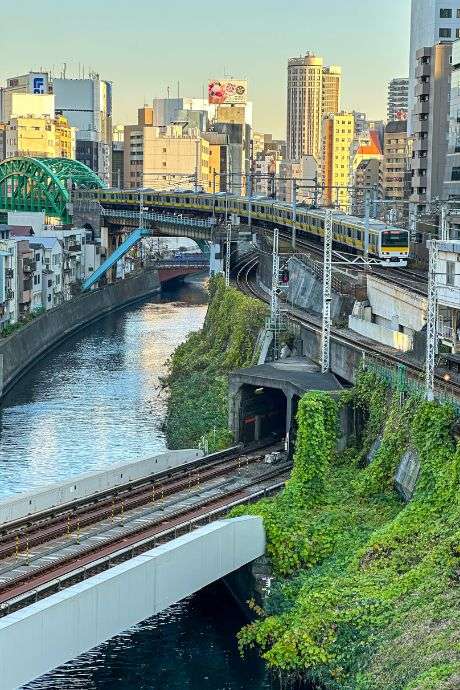
Therefore it is safe to assume many 21-day itineraries across Japan will see great value out of the JR pass, even with a more relaxed journey and at the new prices coming later this year.
Frequently Asked Questions about the JR Pass
- Free Global Shipping through Klook.
- Easy to make and adjust travel plans on the go in Japan
- 7, 14 or 21 consecutive days, with free seat reservations
- Covers most Japan Rail trains, buses and ferries in Japan
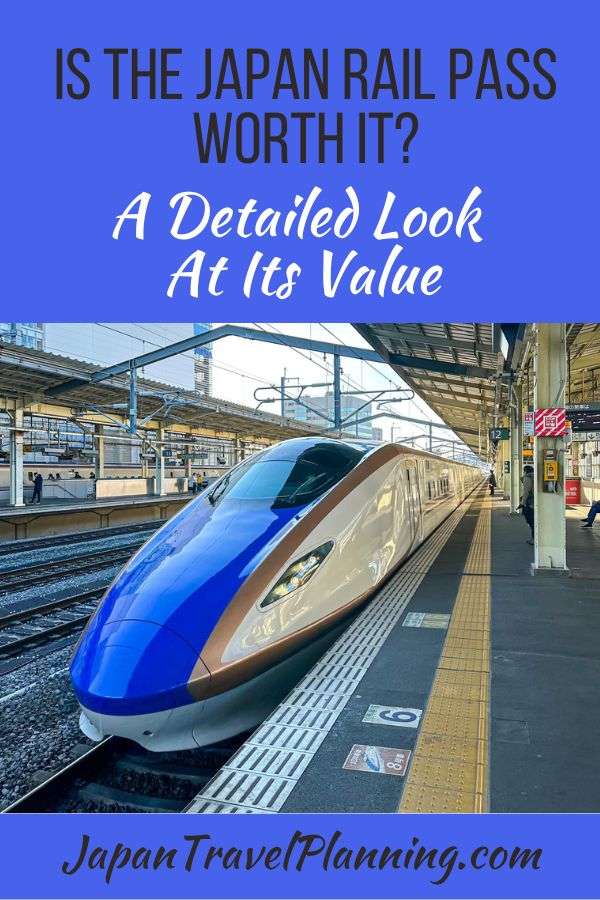
You may also like:
Explore Shinkansen Gran Class: Welcome to Affordable Luxury
The New Spacia X: Travel from Tokyo to Nikko in Style
Reviewing the Odakyu Romancecar: Ride in Panoramic Comfort
Renting a Car In Japan: A Comprehensive Guide for Tourists
Renting a Car in Okinawa: Explore Japan’s Paradise
Driving in Okinawa Guide: Getting Around the Paradise Islands
Join the Japan Travel Planning Facebook Group or Discord Server
You are also welcome to join our Japan Travel Planning Facebook Group and our Japan Travel Planning Discord Server – they are great resources to enable you to ask questions about your upcoming trip to Japan!
Disclaimer: This article contains affiliate links. If you book after clicking on one of these links then we may receive a small commission at no extra cost to you.

